
( Photo Credit: Amesbury News )
By: Mark Allred | Follow Me On Twitter @BlackAndGold277
In the early years of the Amesbury Maples organization, first-team managers Armand Hudon and Emilien “Mickey” Jutras would predominantly scout local talent in the town of Amesbury, Massachusetts. As the team was gaining notoriety in the Merrimack Valley of Essex County with their play on the ice, the need to get better year-by-year sometimes had the organization looking outside of town for additional talent. During the first six winter seasons of the club’s existence, the Maples believed in the homegrown experience but before the 1930-31 campaign changes had to be made to keep the competitive drive alive.
Before the 1930-31 season, the Amesbury club would suffer their first loss when it came to the player on the roster with the death of goaltender Raoul “Chiefie” Lemoine. This was the first time the Maples would go outside of the town’s borders looking for a replacement between the pipes as the “next one” in goal John Reddy was a greenhorn and not up to the task as a developing player. The team would go to Haverhill, Massachusetts to acquire netminder Earl Ryan but would also make another bold move looking to another popular hockey hotbed area in New England which was making noise in the hockey community since the early 1900s.
The game of hockey was gaining popularity in the mid to late 1800s with the influx of French-Canadian citizens migrating down to New England to find work in the thriving horse-drawn carriage and textile mill industries. The first game recorded in the United States was credited to have been played at the St. Pauls Preparatory School in Concord, New Hampshire in 1883. Exeter, New Hampshire was the next area to take off with the interest of the game especially at the Philips Exeter Academy prep school and was a major source of producing talented hockey players for generations. In 1911 the first organized game of “shinny” was played in Exeter which spurred major interest with many playing on several waterways throughout the town.
With the town of Exeter becoming that “hotbed” of hockey talent in the Southern New, Hampshire community, it wasn’t hard for the Amesbury Maples management team to do their due diligence with scouting future talent as Exeter is only 11 miles to the north. After increased negotiations, the Amesbury club got their hands on one of the best up and coming defensemen in the Northeast of the United States working out a deal that would allow this individual to play for the Maples but also return home to play games for his hometown team. The Maples were already known to be a strong “shutdown” defensive club but the acquisition of this player on the backend would make opposing teams fearful as they crossed center ice trying to gain traction in the offensive zone.
George Herbert “Fuzzy” Thurston Jr
Born in Exeter, New Hampshire on September 15th, 1903, to the parents of George H. Thurston and Ellen S. Day Thurston. Father George worked as a was a mortar tender for a successful concrete business in the area and the couple would grow their family to 12 children with only eight of the offspring being mentioned in the 1918 census. The young Thurston (Fuzzy) who was the ninth child in the family picked up the game of hockey quickly as he grew up at two Exeter residents. His first house around the time of his birth was on High Street and later the family moved to the River Street Extension area. Both locations were alongside the Squamscott River where winter season activities were plentiful and nearby for constant development.
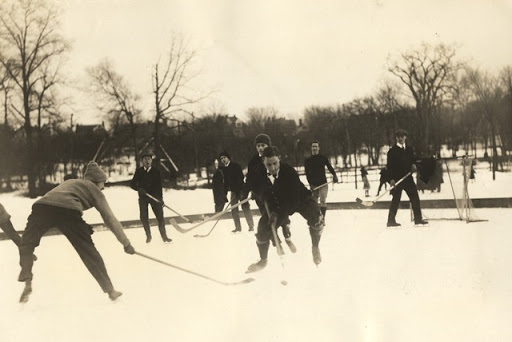
( Photo Credit: HockeyGods.com )
As a young person, Fuzzy would learn the speed of the game on open ice along the mentioned Squamscott waterway but would also take advantage of a flooded rink that was constructed on the Academy’s Plimpton Playing Fields when the local rivers weren’t safe. The flooded rink at Plimpton Field measured 175X75 and on the smaller ice surface, the Thurston honed his defensive attributes. There’s a big difference from the pond or river games as a stray puck sliding away gives participants the time to catch their breaths but in a contained environment the game moves so much faster. Thurston would attend Exeter Public Schools until he was 16-years-old forgoing further education to work with his father in the masonry trade and did not graduate after two-years of High School. In my research assisted by the great folks at the Exeter Historical Society, Fuzzy never attended Philips Academy as he was heavily rumored in previous years.
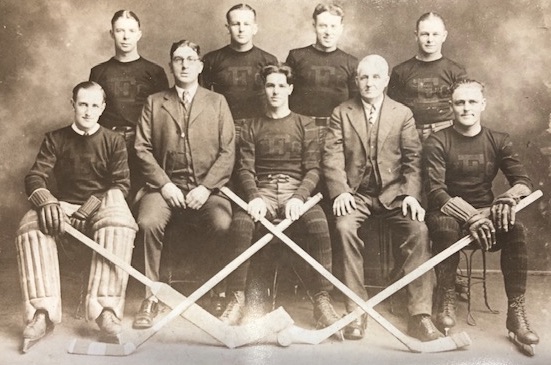
( Photo Credit: Exeter Historical Society )
As an out-of-school 16-year-old working with his father in masonry spending a majority of his time constructing buildings and walls in Hampton, New Hampshire, Fuzzy would join the Exeter Hockey Club halfway through an eight-season run where the team reportedly only lost one game. During this period of time, Thurston played center for the Exeter club making him a valuable asset being able to play multiple positions. After playing many years with the Exeter Sextet, Thurston would extend his playing time and accepted a defensive position with the Amesbury Maples a club who’ve had him in the organization’s crosshairs for quite some time when it came to scouting players from afar.
Fuzzy joined the Maples team in the organizations beginning of National stardom when he donned the Kelly Green and White sweater for the first time in the 1930-31 winter season. That year the hard-hitting defenseman along with a roster of (C) Eddie Nichols, (LW) Charley Broderick, (RW) Albie Roy, (C) Chewy Williams, (W) Archie Cloutier, (D) Everett Picard, (D) Aurel Picard, Tom “Ike” Wall, and goaltenders Earl Ryan and John Reddy would finish Thurstons first season with the Maples compiling an 18-2-1 record. That same year the Maples played so well in the Essex County League the Amesbury club participated in the prestigious NEAAU Tournament which was held at the Rhode Island Auditorium in Providence, RI. This annual postseason regional tournament was constructed of the best amateur hockey teams in New England and the winner of these games would go onto play in the AAU for a chance to win a National title against well known collegiate talent at that time. This was one heck of a rookie season for Thurston but his story is far from over.
Thurston was not only heavily scouted by the Maple team in previous years but was also looked at from the higher levels of hockey as well. After a successful rookie season with the Amesbury team in 1930-31, Fuzzy would only need to play five games for the Maples in 1931-32 where he compiled 13-2-15 numbers ranking him fourth in team scoring. Leading the way in scoring during the 1931-32 winter campaign was Harlan “Chewie” Williams who posted 43-7-50 totals when the Maples club finished that year with a record of 17-4-1. The Amesbury club scored a total of 146 goals that year giving up only 44 all season to their opponents. This number in goals-against was heavily credited to a Maples defense and goaltending that opposing forwards often never got behind.
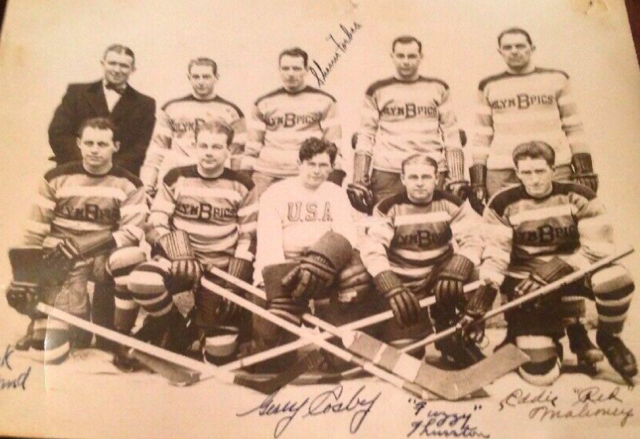
( Photo Credit: HockeyGods.com )
Thurston’s two seasons with the Maples and previous playing career in Exeter didn’t go wary of the keen eyes of the higher Boston Olympics scouting staff who came calling for Fuzzy after only five games in the 1931-32 season. The Olympics organization was a minor-pro team compiled of talented “All-Star” players throughout New England and was owned and operated by Walter Brown. Brown a key member in the development of ice hockey in New England was also the founder of the Boston Celtics in 1945 as manager of the old Boston Garden. The relationship between Brown and Thurston could be dated back to the years between 1923 and 1926 where Brown could’ve watched Fuzzy play as he was close to the Exeter, New Hampshire community as a student of Philips Exeter Academy.
Walter Brown and his team of “All-Stars” which included Thurston would set sail on January 26th, 1932, on the S.S. Majestic for a tour of Europe playing several highly skilled teams along the way. The Boston Olympics six-week tour would see game action in 14 cities and nine different European countries which included stops in popular places overseas like Davos Switzerland, London England, Milan Italy, Munich Germany, Paris France, Prague Czechoslovakia (Now the Czech Republic), and Vienna Austria. The Olympics team would come back to the United States in mid-April of 1932 sailing into New York City aboard the steamship Antonia bringing back an impressive record of 20-1-2 and playing in front of an estimated 90,000 European spectators. During these games abroad, Thurston posted 4-5-9 numbers but was listed as playing center as Brown would have seen him play back in Southern New Hampshire when he was with the Exeter Hockey Club. Without the services of Thurston the very next year in 1933, Brown orchestrated the first gold medal in United States hockey history winning it all at the Ice Hockey World Championships tournament.
Fuzzy also took his hockey talents outside of New England when he was invited to play for the Eastern Hockey Leagues Bronx Tigers. At the time during the 1933-34 season, he was still playing for the Maples organization but left the Amesbury club for the tryout. The Tigers played their games at the Bronx Coliseum in New York City. Thurston only appeared in five games earning zero points in his short stint ultimately leaving New York to finish the winter season back in the Northeast of Massachusetts with the Maples club.
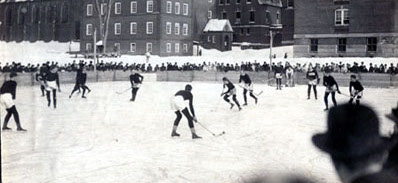
( Photo Credit: Ohrstrom Blog )
After returning from the lavish European trip with the Olympics funded by Brown, Thurston would return to the Maples team and be a cornerstone for the Amesbury club on the defensive backend for the next five seasons. Fuzzy did not play for the Maples during the 1937-38 hockey season accepting a paying job as head coach of the University of New Hampshire’s freshman club. That season without the grizzled veteran on defense, the Amesbury team posted a winter season record of 15-5-1. Thurston would return to the Maples team the following year and would be a consistent presence defensively as the Amesbury team had higher accolades in mind.
The second-biggest thrill in Thurston’s hockey career came during the 1939-40 winter season when he helped the Maples earn an Essex County Championship with a 19-3-2 record claiming a spot in the annual NEAAU Tournament held at the old Boston Garden. The Maples would go onto beat Massachusetts Higham Cove team 3-1 in the quarter-finals, beat Hyde Shoe of Cambridge, Mass. 3-1 in the semi-finals and beat a powerful Sacred Hearts club from Concord, New Hampshire 7-0 in the finals, The Amesbury sextet would go onto win the organizations first and only New England Hockey Championship. The Maples would move up to the National Bracket after their 1939-40 NEAAU title to play in the AAU Tournament held in Lake Placid, New York.

( Photo Credit: Amesbury News )
The Maples team would be involved in a six-team elimination tournament against heavily favored University of Minnesota team that scored 100 goals in 16 undefeated games leading up to the AAU tournament. The Amesbury team received a bye in the first round of the tournament and went right into the semi-final round against the belly of the beast where the Minnesota club was ready and waiting. The game between the Maples and Gophers was pretty close having both clubs tied at two apiece mid-second period but the loss of Thurston on the backend after an injury just made it just too easy for the Gophers who finished the second frame with a 6-2 lead. The Maples would continue to push being a man down and outnumbered when you look at the player’s benches due to the fact that the Gophers came to Lake Placid with a full roster and the Maples did not. Amesbury would go onto score two more goals in the final period at Olympic Arena but Minnesota kept piling it on finishing the contest with a 9-4 Gopher victory ultimately ending Amesbury’s dreams of a National Championship. Thurston had the 2-1 go-ahead goal in the first period before leaving the ice in the second period for the remainder of the game.
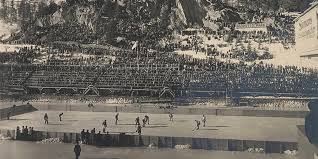
( Photo Credit: TeamGB.com )
After the 1939-40 campaign which was the best known in Amesbury Maples history, the 37-year-old Thurston returned to the team for another triumphant run for a National Title but after a successful season that had the Maples earn a 16-4-1 record, the team from the Northeast once again got into the NEAAU Tournament at the famed Boston Garden. After beating the Lynn Rangers 7-3 in the quarter-finals, beating the Pla-Mor sextet from Lexington, Mass. 3-1, the Maples just didn’t have enough in the tank to beat the Hingham Cove Mass. team losing in the final round by the score of 5-2. After this 1940-41 season, Thurston and the Amesbury team did not see much action on the ice due to World War II and the fact that many of Fuzzy’s teammates enlisted into the war efforts. With a minimal roster and powered light restrictions at night, travel restrictions during the day there were only a couple of games mentioned in the papers from the 1941-42 winter season to the 1947-48 season.
The Maples team was back up to a full roster and regular-season schedule without wartime restrictions in the 1947-48 campaign. The pleasant return of the game to the supporting Amesbury community was also a perfect time to introduce a new home rink on the “flats” of Amesbury. The new rink facility called the Powwow Skating Arena was up to league specifications of 200X85 located on the corner of South Hampton Road and Clinton Street Extention. Unfortunately, Thurston did not play at the new home rink nor did he return to the Amesbury club opting to move back to his hometown of Exeter with his longtime wife Mary V. Thurston. It’s heavily rumored that Fuzzy continued to play hockey until the age of 66 for various Exeter club teams and was also an ambassador of the game when it came to teaching younger players much like the guidance he needed as a member of the Exeter Youth Hockey that he was a part of so many years ago.

( Photo Credit: Amesbury Gazette )
Thurston was a hard worker on and off the ice but when it came to supporting his family he continued to be s self-employed mason that his father George Sr. taught him so many years ago until 1941. His mason skills also got him a job with the Philips Exeter Academy School when he returned home after leaving the Maples team. Fuzzy was employed by Philips Exeter until 1952.
On October 31st, 1987, George Herbert “Fuzzy” Thurston Jr. passed away at the age of 84 at the Exeter Health Care Center after a brief illness. His wife of many years passed away in December the year prior. In 1960 Philips Exeter Academy honored Thurston for his contributions to hockey in the community. He was very active with Exeter Youth Hockey as an administrator and coach for many years following his playing career. He was known as Mr. Hockey to many in the Exeter, New Hampshire area and in 2017 the New Hampshire Legends of Hockey inducted Thurston into their prestigious Hall of Fame immortalizing his playing career along with his commitment to the game and youth development. The New Hampshire Legends Hockey Hall of Fame was established in 2002 to recognize and honor those men and women who have made significant contributions to the sport of ice hockey in New Hampshire by their participation as Players, Coaches, Builders, Officials or members of the Media.
My appreciation to those who’ve contributed to this and many articles in this Amesbury Maples Legend Series
I’d like to thank Mr. Bert Spofford for all his hard work in gathering a majority of Amesbury Maples’s information and stats I used above and in many of these articles. Rest In Peace Bert! As always I have to thank the Picard family for the abundance of newspaper clippings and information that Tammi (Picard) Perkins’ father Alphonse Picard gathered over the years before his passing. Also, a shoutout to the Cloutier family for their contributions when this Maple project originally got started.
Pertaining to this article, I’d like to send my sincere appreciation to Barbera Rimkunas as she’s the Exeter Historical Society Curator and was a great help when I reached out in November of 2019. Although not listed, if anyone else from the Exeter Historical Society helped Barbera in gathering most of the information above, I also want to say thanks for your effort in this project.
Below are some of the websites that I obtained information for this research project on the Amesbury Maples Legend Mr. George H. “Fuzzy” Thurston that I also owe many thanks as another avenue to track down facts along the way.
New Hampshire Legends Of Hockey
If anyone has an old Amesbury Maples hockey equipment, images, or information and would like to contribute to this continued Legends Series, please send me an email to blackngoldhockeyblog@gmail.com and let’s talk! Thank You!
Check out the new Black N’ Gold Hockey Podcast episode 172 that we recorded below on 3-26-20! You can find our show on many worldwide platforms such as Apple Podcasts, Google Podcasts, iHeart Radio, Spotify, SoundCloud, and Stitcher.
[soundcloud url=”https://api.soundcloud.com/tracks/785314012″ params=”color=#ff5500&auto_play=false&hide_related=false&show_comments=true&show_user=true&show_reposts=false&show_teaser=true&visual=true” width=”100%” height=”450″ iframe=”true” /]


Leave a Reply